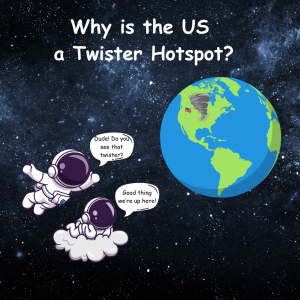Tornado Terrain: Why is the US a Twister Hotspot?
By Danielle Rodriguez, C2ST Intern, Waubonsee Community College
On a warm February night not too long ago, tornado storms swept through my college campus and hit surrounding towns. It was unusual to experience such a storm during a usually calm winter month. When I arrived at class the day after the storm, I saw uprooted trees, light poles completely knocked down, and traffic signs scattered. I began to wonder about how tornadoes form and why the United States experiences so many of them.

To understand why so many tornadoes occur in the U.S., we must first understand how tornadoes are formed. Tornadoes are created during specific kinds of storms called supercell thunderstorms. Unlike regular storms, supercell thunderstorms contain a spinning column of air at their center called a vortex. As the storm grows, the vortex begins to tilt, lifting warm moist air upwards and pushing cold dry air downwards. This exchange of air causes the vortex to grow, and a funnel is formed. Once there is enough pressure and weight from the cold air, the funnel is forced to make contact with the ground and a tornado is born.
The United States in particular experiences so many tornadoes because its geographical location on Earth provides the perfect recipe for tornado formation. The United States’ central region of the Plains and the Mississippi River are covered in grasslands and croplands. These flat landscapes can heat up very quickly and create pockets of warm air. The warm pockets of air combine with the wet air moving north from the Gulf of Mexico, the dry air swooping down from the Rockies, and the cold air descending from Canada’s upper Great Plains. In the United States, the plains, the Midwest, and the South are at the highest risk for tornadoes, but tornadoes are not limited to just these areas. Due to changing weather patterns, other parts of the US are becoming increasingly susceptible to these storms.
Historically, January and February report the lowest tornado counts throughout the United States. When tornadoes do occur, it is typically near the Gulf of Mexico. What is strange about 2024 is that the Midwest region has experienced nearly the same number of tornadoes as the South. The record warmth we experienced in February charged up 23 tornadoes spanning northern Illinois, lower Michigan, Ohio, and New York all within 48 hours. According to private weather company AccuWeather, these abnormal weather conditions may be foreshadowing a stronger-than-average tornado season. However, other experts are hesitant to agree due to the approaching global weather shift from El Nino to La Nina. El Nino and La Nina refer to the natural phenomenon of periodic warming and cooling of sea temperatures. During La Nina, water temperatures in the Gulf of Mexico tend to be warmer than usual, which could generate an influx of tornadoes for the United States.
With unpredictable weather patterns, it becomes increasingly difficult to prepare for and navigate natural disasters. Though scientists have gotten better at speculating the conditions that make tornadoes more likely, it is still difficult to gauge which storms will produce tornadoes and when those tornadoes will form. However, knowing how and where tornadoes form can help us prevent further destruction and keep our communities safe.
References